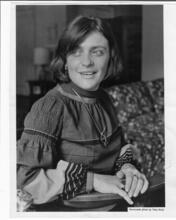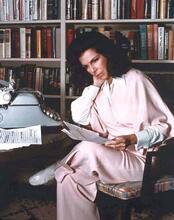Jacqueline Susann
Jacqueline Susann began her career as an actress, appearing on TV, a brief stint on Broadway, and as a TV pitch woman. In 1962, she underwent a mastectomy and threw herself into writing, publishing her first book, Every Night Josephine! in 1963. Her second book, Valley of the Dolls (1966), a saga of the tough life of actresses in New York and Hollywood, quickly reached the top of the New York Times best-seller list, where it remained for a record-setting twenty-eight weeks. Her next books, The Love Machine (1969) and Once Is Not Enough (1973), made her the first author to have three consecutive number-one best sellers. Susann drastically changed book promotion and marketing, using television and print advertising to promote her novels rather than relying on reviews.
Overview and Family
Jacqueline Susann’s first diary was a gift from her grandmother on her seventh birthday. It was of real leather with a lock and key and her initials stamped on the cover in gold to match the edges of the pages. “Sometimes you might feel sorry for yourself,” her grandmother had said, “and when you do put it here, put it in your diary and don’t breathe a word.” All her life she kept a diary. And she kept her sorrows to herself.
Her maternal grandmother, Yuccha (Ida) Kahalofsky Jans, fleeing from pogroms in Kiev, arrived in Philadelphia on February 23, 1882, at the age of fourteen. She was photographed holding her diary, in which she kept a record of the voyage. Ida’s only granddaughter, Jacqueline, was born in West Philadelphia on August 20, 1918. Jackie’s mother, Rose Jans, was a schoolteacher who married a handsome, womanizing portrait artist named Robert Susan. Rose added the second “n” to her teaching name so that her students would pronounce it correctly (“su-zan,” not “su-zun”). Susann’s father was born in Vilna. In 1889, when he was two, his family, who were in the lumber business, were ordered off their land. They immigrated to Shamokin, Pennsylvania, a coal-mining town where they had kin. The name Susan is derived from Shushan, the capital of Persia. The family claimed descent from the de Suzanne who raised most of the money for Christopher Columbus’s first voyage. Most of the de Suzannes were killed in the Inquisition. Survivors fled first to Holland and then to Vilna in the Duchy of Lithuania and were established there by 1568, the year that Jews were required to register with the government and pay a poll tax.
Personal Life and Acting Career
: In December 1962, when she was forty-four years old, Jacqueline Susann found a breast lump and was scheduled for a biopsy the next morning. “I can’t die without leaving something—something big,” she wrote in her diary. “I think I can write. Let me live to make it.”
Jackie grew so disciplined after her mastectomy that during the remaining twelve years of her life she went from failed actress to the richest self-made woman in America, and the first to have three New York Times number one best-sellers in a row. Valley of the Dolls sold twenty-nine million copies. No wonder Jackie boasted, “Yeah, I think I’ll be remembered. … I’ll be remembered as the voice of the 1960s. … Andy Warhol, the Beatles and me.”
After her surgery, Jackie (like Jennifer in Valley of the Dolls) considered suicide by pills, or “dolls” as she called them. Life seemed very bleak. Her husband, Irving Mansfield (né Mandelbaum), once a prominent theater publicist and then Arthur Godfrey’s original producer, was out of work. Their sixteen-year-old autistic son, Guy, would need to remain in a costly psychiatric facility for the rest of his life. Jackie’s mother, Rose Jans Susann, now retired, was going blind. But the bold and brassy Susann was surprisingly religious, in her way. Her relationship with God was emotional. When her father died in 1957 she “got even” with a short-lived conversion to Catholicism. In 1963, overflowing with despair, contemplating suicide, she felt the presence of God while sitting under a tree in Central Park with her poodle, Josephine. She and God reached an agreement. She would “settle” for only ten more years of life. He would make her the most popular author in the world. Instantly, she sold her first book, a collection of Josephine’s adventures, culled from her diaries and letters to friends. Susann admitted she was no great writer but she could “tell a helluva story.” She handed in sprawling manuscripts and counted on her editors to “make everything track.” As a TV pitch woman, it was she who brought in the sponsor, Schiffli Embroidery, who put Mike Wallace on Night Beat, the local New York interview show which propelled him to sudden stardom in 1956. Night Beat made a mini-star of Josephine as well, for she often appeared with Jackie in matching mother-and-dog embroidered collars and coats.
Writing Career and Valley of the Dolls
Every Night Josephine, “a report from the other end of the leash,” published by Bernard Geis Associates in November 1963, did well for a first book (35,000 hardcover copies) but set no sales records.
Susann’s second book and first novel, Valley of the Dolls, published on February 10, 1966, quickly reached the top of the New York Times best-seller list, where it remained for a record-setting twenty-eight weeks. It was a saga of the tough life of actresses in New York and Hollywood, most of it direct from her diaries, and but thinly disguised. She presented her editor, Don Preston, with an eighteen-karat gold money clip, bearing a pair of tiny gold scissors, which came wrapped in a note thanking him for “the kindest cuts of all.” Yet Preston recalls: “When Jackie really liked a phrase she wouldn’t change it. We went back and forth on the opening where she calls New York an ‘angry concrete animal.’ It stayed in.” Neither would she give way on the title although the book distributors hated it, arguing that bookstore personnel might put the book in the children’s section.
Her second novel, The Love Machine, published May 14, 1969, remained number one on the New York Times best-seller list for twenty-six weeks. Robin Stone, the womanizing protagonist, had the same initials as her father, Robert Susan, and equal sex appeal. Her third novel, Once Is Not Enough, revealing her own Electra complex, was published on March 20, 1973, and also rose to the number one spot at the Times. Unbeknownst to any but her husband and a few close friends, Susann was at the time terminally ill with metastatic breast cancer that had spread to her lung and required chemotherapy treatments at almost every stop on her publicity trail. Nevertheless, she managed to fly to London with her friend Doris Day, with whom she worked closely on animal rescues, to promote the British edition of Once. She died on September 21, 1974, God having had the grace, she believed, to allow her the extra year and a half to complete her third novel and assure her unique place in publishing history.
Susann set an unequalled record. Not only was she the first to have three number one best sellers in a row, but she drastically changed book promotion and marketing, taking power away from book critics and transferring it to authors with the skills to promote their products on television. She is credited with inventing the “brand name” novel that needs no reviews, only an announcement that the author’s latest work has arrived in the stores.
Jackie Susann was confrontational, sassy, entertaining and proud of her achievements. “A new book is like a new brand of detergent,” she explained. “You have to let the public know about it. What’s wrong with that?”





